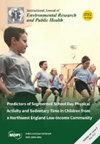家庭饮食环境对阿联酋在校青少年饮食行为、家庭膳食和学习成绩的影响
3区 综合性期刊
Q1 Medicine
International Journal of Environmental Research and Public Health
Pub Date : 2024-09-06
DOI:10.3390/ijerph21091187
引用次数: 0
摘要
青少年时期养成的饮食行为(EB)和习惯往往会持续到成年,而父母和看护人在塑造孩子的饮食选择方面起着重要作用。家庭环境是青少年饮食行为形成的重要环境。本研究旨在探讨家庭饮食环境(HFE)及其相关因素对阿拉伯联合酋长国(UAE)在校青少年的饮食、家庭膳食(FMs)和学习成绩的影响。我们对阿联酋的 304 名学龄青少年进行了横断面研究。问卷内容包括社会人口学数据、饮食习惯、与 HFE 相关的信息(食物的可用性和可获得性)、体育活动、睡眠模式和学习成绩。几个问卷项目合并后得出 HFE 分数。这些问题包括每周家庭聚餐的频率、膳食准备方法、家中健康和不健康食品及零食的可获得性。HFE 分值被二分为有利和不利 HFE 分值。同样,EB 和 FM 分数也是通过合并对各种相关问题的回答得出的。对参与者的体重和身高进行了测量。结果显示,超过一半(55%)的青少年超重或肥胖。大多数参与者的 HFE(57.2%)、EB(69.1%)和 FM(58.2%)得分良好。与 HFE 显著相关的因素如下:父母上过大学的男性参与者(OR:0.31;95% CI:0.15-0.62;p < 0.001)、学习成绩优异者(OR:1.98;95% CI:1.02-3.82;p = 0.043)和身体活跃者(OR:1.80;95% CI:1.14-2.85;p = 0.012)更有可能具有良好的 HFE。此外,HFE 评分与 EB 评分(r = 0.573,p < 0.001)和 FM 评分(r = 0.384,p < 0.001)呈高度显著的正相关。这些结果强调了健康的 HFE 在塑造青少年健康积极的饮食行为和食物选择方面的关键作用。它们为制定有效的循证政策奠定了基础,这些政策将对阿联酋青少年的健康和学业成功产生影响。本文章由计算机程序翻译,如有差异,请以英文原文为准。
The Influence of the Home Food Environment on the Eating Behaviors, Family Meals, and Academic Achievement of Adolescents in Schools in the UAE
The eating behavior (EB) and habits developed during adolescence tend to persist into adulthood, with parents and caregivers playing a significant role in shaping their children’s food choices. The home environment is a crucial setting for developing eating behavior during adolescence. This study aimed to explore the influence of the home food environment (HFE) and its correlates on EB, family meals (FMs), and academic achievement among adolescents in schools in the United Arab Emirates (UAE). A cross-sectional study was conducted with 304 school-aged adolescents from the UAE. The questionnaire included sociodemographic data, dietary habits, information related to the HFE (food availability and accessibility), physical activity, sleep patterns, and academic achievement. Several questionnaire items were combined to create an HFE score. These questions included the frequency of weekly family meals, meal preparation practices, and accessibility to healthy and unhealthy food products and snacks at home. The HFE score was dichotomized into favorable and unfavorable HFE scores. Similarly, EB and FM scores were generated by combining responses to various related questions. The participants’ weights and heights were measured. The findings reported that more than half (55%) of the adolescents were either overweight or obese. The majority of the participants had favorable HFE (57.2%), EB (69.1%), and FM scores (58.2%). The significant correlates to the HFE were as follows: male participants whose parents attended college (OR: 0.31; 95% CI: 0.15–0.62; p < 0.001), high academic achievers (OR: 1.98; 95% CI: 1.02–3.82; p = 0.043), and those who were physically active (OR: 1.80; 95% CI: 1.14-2.85; p = 0.012), were more likely to have favorable HFE. Moreover, the HFE score showed a highly significant positive correlation with the EB score (r = 0.573, p < 0.001) and the FM score (r = 0.384, p < 0.001). These results underscore the critical role of a healthy HFE in shaping healthy positive eating behaviors and food choices among adolescents. They provide a foundation for developing effective, evidence-based policies that can impact the health and academic success of adolescents in the UAE.
求助全文
通过发布文献求助,成功后即可免费获取论文全文。
去求助
来源期刊

International Journal of Environmental Research and Public Health
Medicine-Public Health, Environmental and Occupational Health
CiteScore
7.30
自引率
0.00%
发文量
14422
审稿时长
1 months
期刊介绍:
International Journal of Environmental Research and Public Health (IJERPH) (ISSN 1660-4601) is a peer-reviewed scientific journal that publishes original articles, critical reviews, research notes, and short communications in the interdisciplinary area of environmental health sciences and public health. It links several scientific disciplines including biology, biochemistry, biotechnology, cellular and molecular biology, chemistry, computer science, ecology, engineering, epidemiology, genetics, immunology, microbiology, oncology, pathology, pharmacology, and toxicology, in an integrated fashion, to address critical issues related to environmental quality and public health. Therefore, IJERPH focuses on the publication of scientific and technical information on the impacts of natural phenomena and anthropogenic factors on the quality of our environment, the interrelationships between environmental health and the quality of life, as well as the socio-cultural, political, economic, and legal considerations related to environmental stewardship and public health.
The 2018 IJERPH Outstanding Reviewer Award has been launched! This award acknowledge those who have generously dedicated their time to review manuscripts submitted to IJERPH. See full details at http://www.mdpi.com/journal/ijerph/awards.
 求助内容:
求助内容: 应助结果提醒方式:
应助结果提醒方式:


